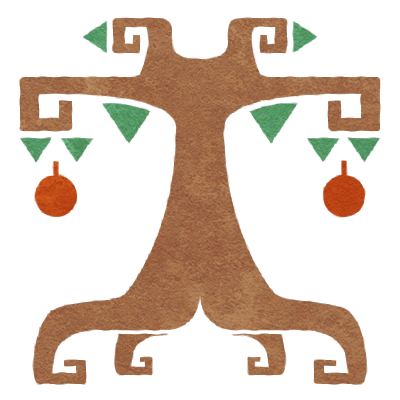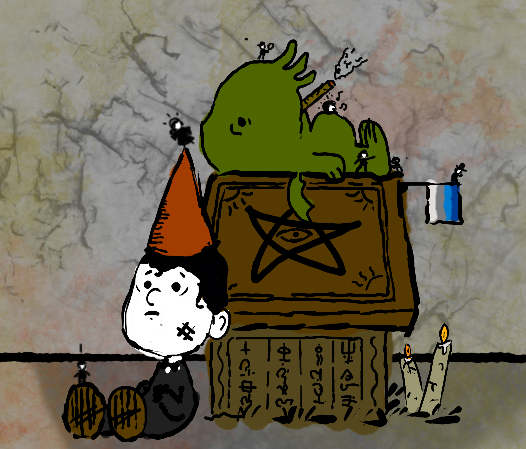We are but one among many, remember to treat the world kindly— and it will show you kindness in turn.The Hontualieu are a spiritual people, holding great respect for the world around them. They do not worship any gods— but believe that all things have spirits within them.
For racial information, read,
A Forceful Alliance
A silent protest
Despite their subjugation and mistreatment at the hands of the Lliaqeu, the Hontualieu seldom choose to fight back. Their armies vanquished, and their settlements commandeered, they protest the conqueror's rule passively with what is too often denied them— kindness. While the Lliaqeu may see this as the Hontualieu's great weakness, the Hontualieu see it as their greatest strength.Kindness is a virtue, and even when the despicable spit upon you— do not spit back. That is merely what they want of us— the loss of our greatest value.
Tradition & Values
Milestones
Birth
When a Hontualieu child is born, the mother will try to do so outdoors— believing that if they do not, the child's cluetqep, or guardian spirit, will forever be unable to find them. Afterwards, the child is embraced by their parents— little to no ritual is involved, as to them, birth itself is a ritual.Coming of age
Upon reaching the age of 15, Hontualieu go through the Tokqet a ceremony where the child stands in a small round tub as their family showers them with mud from the Cipou river. The child must then wait in the tub for an hour with their eyes closed, before getting up and washing off the mud in the river. This is believed to firmly plant the child as part of the world.Greetings & Farewells
When greeting someone, Hontualieu place their left hands on each other's right shoulder— or the left for close friends and family. Farewells are executed with a simple nod of the head.Ha, no, child, you do not need to greet each and every thing you pass by— only your fellow man, otherwise you'd never stop!
Death
The dead are wrapped in a layer of mud, left to dry in the sun, and set upright within graveyards carved into the red walls of the canyon. These mud sarcophagi are kept still with more mud placed around their feet once they are placed. Clothing and jewelry are taken off before they are covered, and often placed over the statue once dried. Their family, friends— or neighbors, if no one cared for the departed— will carry out the deed. This is believed to return the dead to the earth they came from.Eating & Taboo
Out of respect for the land, crops, and animals that became their meals— the Hontualieu do not leave food unfinished. If one is going to take something, or worse— kill something— and not make full use of it, they are greatly insulting it. Those who waste food will be met with disappointed sighs at best, and angry shouting at worst. In most cases, they will typically relent and finish their food, or someone else will eat it in their stead.Pastimes
Hontualieu are often gifted at telling stories, it is a skill practiced from the moment they are born. Parents tell their children stories of the world around them, of why things work the way do, of their family's past, of their own past, or make them up simply to be entertaining. Before long, the children begin to tell stories among themselves, eventually growing into adults attempting to impress one another with their skills— carrying on this tradition until the day they die. Story telling can become a sort of lighthearted competition, each will often add their own spin to well-known stories, be it a tweak here and there, a character voice, sound effects, or drastically altering it to suit their tastes.War
Before battle, they will bury their weapons under a light coat of dirt and pray over them for protection. The fallen, whether they be one of their own, or from the opposing side, will be properly buried. If the numbers are too high to viably carry out this task before the bodies begin to rot, they will be buried in mass graves covered with mud.Ideals, Love & Gender
Relationships
Unlike some of their contemporaries, Hontualieu culture does not pressure people into marriage. Many pursue it anyway, because they want to— not because they feel as if they have to. Those who do seek out love, look for whoever they are happiest with— regardless of gender or even species, so long as all parties involved are sentient.What came from the same, beautiful, world we were born into cannot be unnatural.
Beauty
Most Hontualieu keep their hair relatively short, only growing it as far as the shoulder. Simple braids are often seen at the bottom corners of these longer hairstyles. Men do not often keep facial hair, though most Hontualieu cannot grow much it to begin with.Gender
One's role in society is mostly left to their skills and interests, not their bodies. The only particular split between genders is that women have the final say when it comes to marriage, as they are the ones who bring others into the world.Art, Architecture, and Dress
Art
Hontualieu art tends to focus on scenes of daily life, natural beauty, or spiritual figures— especially one known as Auroul or, The Mother— a figure many believe to be the first human, who gave birth to mankind. Painting along the red walls of the canyon is common, and in some places murals span far outside city limits. Weaving and dyeing, are other popular forms of expression— especially with close proximity and ease of access to dyes produced by the Poltoul Dye-works.Architecture
Most Hontualieu Architecture is built from adobe made with the red stone and mud found throughout Ciopou Canyon. Most structures are built with slightly angled walls, though flat walls are not entirely unheard of. Most roofs are built from flat layers of compacted mud and gravel, placed ontop of a viga— a set of timber supports which stick out of the walls. For those with easier access to skilled masons than timber— rounded adobe roofs are a more viable option, and punctuate the skylines of Hontualieu settlements. Other buildings are often found within the cliffsides, some carved into the walls, and others simply set against the cliff as is. Typical Hontualieu homes are fairly modest in size, with only one to three rooms in total. Most homes are occupied by small families, with extended family often living nearby— though it is not unheard, nor thought of as strange, to live with extended family in a packed home.Dress
How one dresses depends heavily on how much time they typically spend in the sun.If one can afford it, yellow, blue, and purple robes are not too uncommon, either. Along with differing colors, some robes may have a small split down their front— freeing more skin. Expensive robes will have designs woven into their surfaces.
Capes are commonly dyed with colors that contrast the robe beneath, pairing reds with off-whites, pinks with blues, and so on. More expensive capes will have more intricate floral or simple shapes woven into their fabric.
Religion & Myth
Frightening lizards
It is believed that, once, a great many years ago, there was a demon named Cau. Cau used to be a normal man— until, in his anger— he killed and ate a man for sleeping with his beloved. He became a demon, gaining powers with which he subjugated his small town— consuming anyone who opposed him. Soon, other villages came under his control— and he wished to take the nearby city. As he tore his way towards the palace, standing upon a wall, demanding the king come out— he was startled by a small lizard that had been resting on the wall. It hissed at him, baring its teeth. Surprised, and frightened— Cau took a step back, and fell off the wall— plummeting directly to his death.Before his death, however, the demon had many wives and concubines— his children were warped, and became the monsters known today. It is believed that monsters fear lizards— and those who wish for protection keep symbols of them, worn as necklaces, painted on their homes, or kept on their banners. Some even keep lizards as pets.
Naming
Hontualieu naming traditions are shared with those of Qetlec.When married, the first names of both parties are combined.
This name is then given to their children.
Ex. Calca and Cihe marry, becoming Calcacihe and Cihecalca. Their son is named Qich Cihecalca.









Mmmm... dem headers tho. So I like how you set up them and... the other ethnic group ( more that in a sec. ) as cousins in a way. They are very different from their cousins tho. Right from the get go you can tell they have different values. So something I'm running into... I can't pronounced these names. Lol id love to see a phonetic listing or maybe even put the pronounciation in parinthesis beside these awesome words. " for close friends and family. Farewells are executed with a simple nod of the head" same as before, how did this develop and why? I must know! Also, godddd the milestones section is awesome. The details and unique cultural elements like the coming of age ritual is gold. I do have a question tho. The lliaq started much earlier in their coming of age. I'm curious. Why is this different between them? So few people discuss the art of ethnic groups and cultures. It makes so happy I could cry, plus its unique. It stands apart from the liaq who stand apart in their own way. The religion is just awesome and the touch with Cao is also good. So at this point I notice the pronounciation there. I'm on mobile so the sidebar is at the bottom. If you do this on every article.... touche... I stand corrected. I do think it could still be beneficial to do the pronunciation in parinthesis beside the word but Oof that was cool to see.
Thank you!
For phonetic pronunciation, I put it at the top of the sidebar and try to add tooltips for words used in the body of the article! (Though, I cannot do so for article LINKS, as excerpts override tooltips— but those pages do have the phonetics on them, too!)
How did the handshake develop, and why? I don't explain all the greetings and farewells I write up since, like us and many before us, people don't always know why they carry a tradition. (Also in the interest of time/laziness— I have self imposed deadlines!)
As for why the coming of age is different between the two, the Lliaqeu are more utilitarian and want their children to begin training as soon as feasibly possible. The Hontualieu see childhood as a longer process.
Art is important for any group! Though, perhaps I have a bias...
Yeah! I do set up the pronunciation that way, as well as tooltips (which I assume on mobile you just tap to show). I DO need to actually work on my CSS for mobile! Perhaps there's a way I can set it up to show at the top there? I need to experiment to really see!
Generally, I think you're fine on that. I actually skip anything that looks like a link, so my bad! So sorry. If I tap a link it won't show excerpts so I never bother. They show up differently but I never really tried. My own fault! And yes, this is true but so few really do that. Art is important. As far as the greetings and such, I totally get that but I never want to leave an article critique and not suggest as much to expand on as possible. I generally only critique what I'm asked to, or when I'm returning one in kind. Only other time is when I find an article/world that I love. (ie: right now). I don't want to waste it XD This is true what you say. We often don't know where the handshake came from. We wonder and infer though! There are psychological reasons why we shake hands, and linguistic elements for why we say goodbye. For example. The french have two words for parting ways. Au revoir and Adieu. One is more casual and used like we say goodbye, but adieu is more for someone you can't forsee talking to ever again. A final farewell, if you will. :) It's not a major thing though. I just wondered if you had an answer. I mean the lizard symbols that seem to represent the two are inversed if I remember right. gotta inquire with this level of detail.